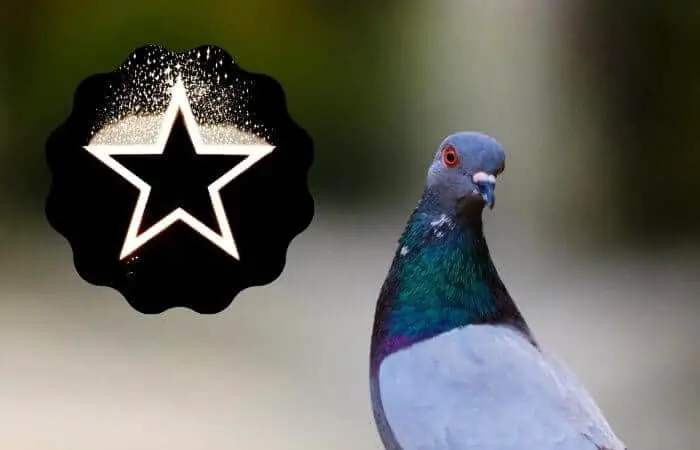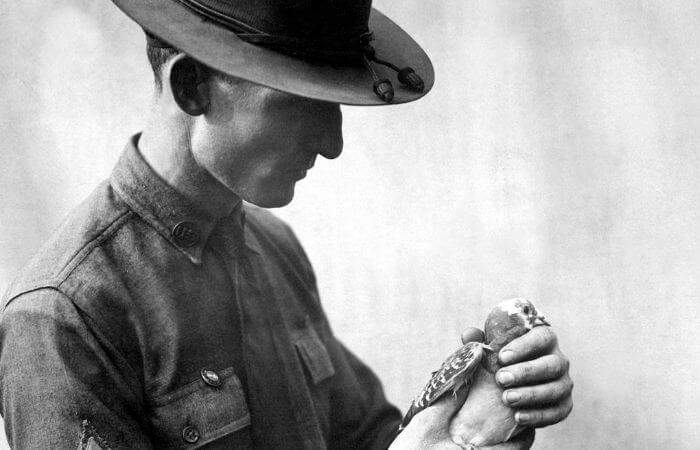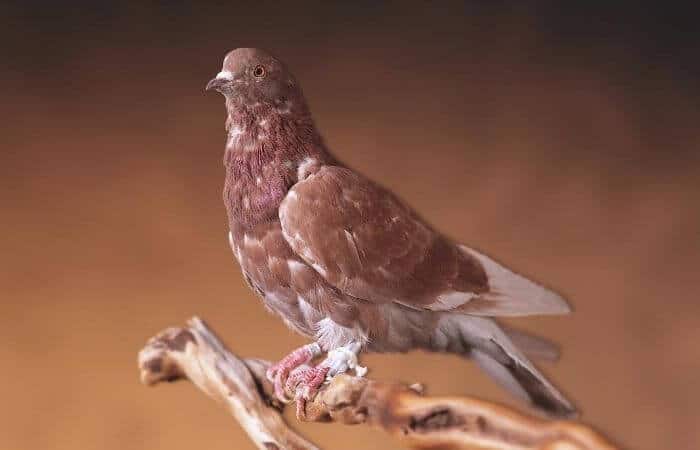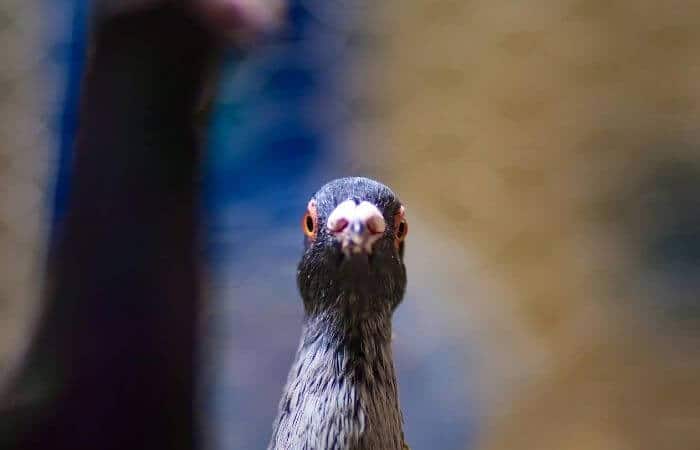Mankind’s relationship with pigeons stretches back into ancient history.
The pigeon as a symbol, has, through different ages and cultures, become a universal symbol of peace and love.

In many cultures, it became to represent the divine. In the Christian religion it has been depicted as the representation of the Holy Spirit.
So, it is no surprise that some pigeons or representations of them in one form or another, have become famous. They have popped up in real life, art, and fiction.
War Hero Pigeons and The Dickin Medal
In times past messenger or carrier pigeons were used for fast, long-distance communication. Inevitably, they were also used when countries went to war.
The Dickin Medal was proposed by Maria Dickin in 1943 to honour the bravery and courage of our animal friends in Britain.

It is now known as the animal equivalent of the Victoria Cross, which is awarded to men and women for great valour.
Traditionally, the award is presented by the Lord Mayor of London. Some of histories most famous pigeons have been recipients of the Dickin medal.
1. Cher Ami
In 1918, during the First World War, a French military pigeon called Cher Ami was the first to be publicly honoured for its war effort.
In October of that year the 77th Infantry Division was cut off and surrounded by German troops.
Unable to breakout, the commander made repeated attempts to appraise his headquarters of the situation, but every messenger bird he sent was either wounded or killed.
Cher Ami was the last messenger remaining bird he had. Although also wounded twice, once in the chest and once in the leg, which was almost shot off and carried the message tube, the valiant bird delivered the message.
A rescue mission was mounted and the soldiers of the 77th were saved from being either captured or killed.
The authorities recognised Cher Ami’s bravery by awarding her the French Croix de Guerre with Palm, which honours heroic service.
Sadly, Cher Ami couldn’t recover from her wounds and died the next year.
2. Winkie
Winkie is said to be the first carrier pigeon to receive the Dickin Medal for his life saving efforts during the Second World War.
In 1942 a British bomber was shot down over the North Sea. Although the crew were alive, they were stranded in a dinghy and in danger of dying of exposure.
They tied a message capsule to Winkie’s leg with their approximate coordinates and he flew 129 miles to the Scottish coast.
A rescue boat was sent, and the crew survived.
3. Kenley Lass
Kenley Lass received the medal in 1945 for her wartime efforts.
She was parachuted into Occupied France with an Allied agent in 1940.
She was the first messenger bird to successfully communicate between the French Resistance and Allied Headquarters in Britain.
4. Mary
Mary also received the Dickin Medal of Honour.
She endured five years of wartime service, flying dangerous missions to deliver vital messages.
Amazingly, she survived being wounded a total of twenty-two times! Sadly, she died in service.
Mary was laid to rest in Northernhay Gardens in Exeter, where she was born and raised.
5. GI Joe
In Italy, 1943, during the Second World War, British troops were ordered to take the town of Colvi Veccia.
The German forces were well dug in and showing strong resistance.
Believing that the British forces couldn’t oust the German troops the U.S. Command decided to flatten the town with an aerial bombardment, but they were wrong.
The British troops had already occupied the town. Due to bad communication, a messenger bird, GI Joe, was sent off.
This bird flew 20 miles in 20 twenty minutes to deliver its message.
It got there just in time, as aircraft were taxing on the runway, ready to start the air raid. The raid was called off and a fatal mistake was adverted.
GI. Joe’s flight saved the lives of not only the British troops, but an untold number of civilians that were still in the town.
GI. Joe also won the Dickin Medal.
Also Read:
7 Famous Pigeon Fanciers
The Best Racing Pigeon Books
Other Pigeon War Heroes
Cher Ami and GI. Joe are probably the most famous of the wartime pigeons, with something about their stories striking a cord with the public, but they weren’t the only ones who were awarded honours for their bravery and service.
If you care to investigate you will find a surprisingly long list of pigeons whose valour has been recognised.

Thirty-two of these Signal Corps warrior pigeons have received the Dickin Medal. By 1948 the use of pigeons by the British armed forces was stopped, but it is rumored that MI5 secretly sponsored some private lofts, just in case.
In Worthing, West Sussex, within the grounds of a Regency listed building called Beach House Park, you will find a memorial to those wartime pigeons that was unveiled on 27th July 1951.
Pigeons in Art
Jose Ruiz y Blasco, 1838-1913, a Spanish painter and father of Pablo Picasso was noted for his paintings of animals, which included doves and pigeons.
Pablo Picasso, the world famous abstract painter exhibited lots of paintings representing pigeons, Child with a Dove, 1901, The Pigeon, 1912, Pigeons, 1943 and La Gros Pigeon, 1947, are just a few.
In fact, much of his artwork includes pigeons, there’s even a lithograph titled The Dove, and although the pigeons themselves aren’t famous, his artwork certainly is.
His most famous and controversial painting, Guernica, produced in response to the fascist bombing of the Basque town also includes a dove.

The dove or pigeon became the universal peace sign, which Picasso helped to popularize.
Indeed, Picasso was so taken with these birds that he kept fantails and he named his daughter Paloma, which is the Spanish word for pigeon/dove.
The Two Pigeons, produced in 1952, is an etching by another famous artist, Mark Chagall
There is also a famous photograph taken by the celebrated photographer Henri Cartier Bresson of the famous artist Henri Matisse, where he is surrounded by pigeons.
Throughout history the dove, the ancestor of today’s pigeon has been used on official seals, coins and bank notes.
Pigeons In Popular Culture
Pigeons appear in most media in popular culture – some named, many more anonymously.
For example, there’s rarely a movie that includes London that doesn’t have a shot of the pigeons in Trafalgar Square. And it isn’t just Trafalgar Square, Pigeons feature heavily in the song “Feed the Birds” milling around the old woman on the steps of St. Paul’s Cathedral in the Walt Disney movie, “Mary Poppins”.
Another pigeon offering from Disney is a full-length animation called Valiant, released in 2005.
Valiant is a pigeon who enrolls in the Royal Homing Pigeon Service during the Second World War.
Another famous pigeon was the character of Yankee Doodle Pigeon in Hanna-Barbera’s cartoon film of Dastardly and Muttley in Their Flying Machines, originally titled Stop the Pigeon, about a patriotic messenger pigeon.
The characters were a spinoff from another cartoon called Wacky Races.
The cartoon ran from September 1969-January 1970 and became very popular with young children.
Sticking with cartoon pigeons, a mention must go to “The Goodfeathers”, a series produced by Animaniacs.
The characters are parodies of the roles played by Robert De Niro, Joe Pesci, and Ray Liotta in the gangster movie, “Goodfellas”.
It also features Godpigeon, a parody of Marlon Brando’s Godfather and a parody of Steven Seagal called Steven Seagull.
One special pigeon may be remembered by the followers of the 1980s comedy TV show called Blackadder Goes Forth.
In one episode Blackadder is arrested for shooting and eating a carrier pigeon called Speckled Jim.
Unfortunately for Blackadder, the pigeon is really the beloved pet of General Melchett and Blackadder is court-martialed (don’t worry, he gets off!).
Pigeons have also appeared in comic books/strips.
One of the most notable examples is the collection of pigeons owned by Andy Capp, a strip cartoon that has been appearing in the British newspaper “The Daily Mirror” since 1957.
